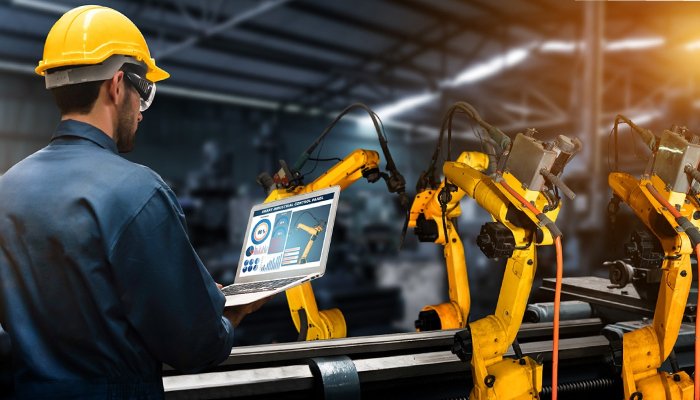Hey there, tech enthusiasts and industry buffs! Buckle up because we’re diving into the exhilarating world of manufacturing. The year is 2024, and it’s an exciting time for global manufacturing. We’ve got robots doing the heavy lifting, factories that think for themselves, and green practices that are saving our planet one product at a time. If you’re curious about the innovative trends shaping global manufacturing in 2024, you’re in the right place.
The Dawn of AI and Robotics
AI: The Brain Behind the Brawn
Artificial Intelligence isn’t just a buzzword anymore; it’s the brains behind modern manufacturing. With AI, factories are getting smarter, faster, and more efficient. Gone are the days of human error and inefficiency.
- Predictive Maintenance: AI can predict when machines are about to fail, saving time and money on unexpected breakdowns.
- Quality Control: With machine learning, AI can spot defects that the human eye might miss, ensuring top-notch quality every time.
- Supply Chain Optimization: AI helps streamline supply chains, reducing costs and speeding up delivery times.
Robotics: The Muscle in the Factory
Robots are no longer just in sci-fi movies; they’re in our factories, too! And they’re not just doing repetitive tasks. These robots are smarter, more adaptable, and incredibly precise.
- Collaborative Robots (Cobots): These robots work alongside humans, enhancing productivity without replacing the workforce.
- Automated Guided Vehicles (AGVs): These are used for transporting materials within factories, reducing the need for human intervention.
- 3D Printing: Robots equipped with 3D printing capabilities can create complex parts on demand, revolutionizing custom manufacturing.
The Internet of Things (IoT): Connecting the Dots
IoT is making everything smart, from our homes to our factories. By connecting machines and systems, IoT is bringing a new level of efficiency and insight into manufacturing.
Smart Factories
Smart factories use IoT to connect all parts of the production process, creating a seamless flow of information and materials.
- Real-Time Monitoring: IoT sensors track machine performance in real time, ensuring optimal operation and quick response to issues.
- Data-Driven Decisions: With IoT, factories collect vast amounts of data that can be analyzed to make informed decisions about production processes.
- Energy Management: IoT helps monitor and manage energy usage, reducing costs and environmental impact.
Digital Twins
A digital twin is a virtual replica of a physical object or system. In manufacturing, digital twins can be used to simulate and optimize production processes.
- Prototyping and Testing: Before a product is made, its digital twin can be tested and optimized, saving time and resources.
- Performance Monitoring: Digital twins can monitor the performance of machinery, predicting failures before they happen.
- Process Optimization: By simulating different production scenarios, digital twins help find the most efficient and cost-effective methods.
Sustainable Manufacturing: Green is the New Black
Images of Innovative Trends Shaping


Eco-Friendly Materials
Manufacturers are increasingly turning to eco-friendly materials to reduce their environmental footprint.
- Recycled Materials: Using recycled materials not only reduces waste but also lowers production costs.
- Biodegradable Plastics: These materials break down naturally, reducing pollution and the impact on landfills.
- Sustainable Sourcing: Ensuring materials are sourced from sustainable practices helps protect ecosystems and biodiversity.
Energy Efficiency
Energy efficiency is not just good for the planet; it’s good for business too. Lower energy consumption means lower costs and a smaller carbon footprint.
- Renewable Energy: Many factories are switching to renewable energy sources like solar and wind power.
- Energy-Efficient Equipment: Upgrading to energy-efficient machinery reduces power consumption and operational costs.
- Smart Lighting and HVAC: IoT-enabled systems optimize lighting and heating, ventilation, and air conditioning (HVAC) for maximum efficiency.
Additive Manufacturing: The Future is Layer by Layer
Additive manufacturing, or 3D printing, is taking the industry by storm. It allows for the creation of complex parts and products with minimal waste and maximum customization.
Customization and Flexibility
One of the biggest advantages of 3D printing is the ability to create customized products on demand.
- Personalized Products: From medical implants to custom car parts, 3D printing allows for high levels of personalization.
- Rapid Prototyping: Designers can quickly create prototypes, test them, and make adjustments without the need for expensive molds or tooling.
- On-Demand Production: 3D printing enables manufacturers to produce items only when needed, reducing inventory and storage costs.
Material Innovation
The materials used in 3D printing are constantly evolving, opening up new possibilities for manufacturing.
- Metal 3D Printing: This allows for the creation of strong, durable parts that are used in industries like aerospace and automotive.
- Composite Materials: Combining different materials in 3D printing can create parts with unique properties, such as increased strength or reduced weight.
- Bioprinting: In the medical field, bioprinting uses living cells to create tissues and organs, revolutionizing healthcare.
Blockchain: The Security Guard of Manufacturing
Blockchain technology isn’t just for cryptocurrencies; it’s making waves in manufacturing too. By providing a secure and transparent way to track transactions and data, blockchain is boosting trust and efficiency in the industry.
Supply Chain Transparency
With blockchain, every step of the supply chain is recorded and immutable, ensuring transparency and accountability.
- Traceability: Blockchain allows for the tracking of materials from their source to the final product, ensuring authenticity and reducing counterfeiting.
- Efficiency: By streamlining and securing supply chain transactions, blockchain reduces delays and costs.
- Compliance: Ensuring regulatory compliance is easier with blockchain, as it provides a clear and unchangeable record of all activities.
Smart Contracts
Smart contracts are self-executing contracts with the terms directly written into code. They’re revolutionizing manufacturing by automating processes and reducing the need for intermediaries.
- Automated Payments: Payments can be automatically released once conditions are met, reducing the need for manual intervention.
- Quality Assurance: Smart contracts can ensure that products meet specific standards before they’re shipped.
- Inventory Management: Automating inventory management reduces the risk of overstocking or running out of materials.
The Human Touch: Workforce Transformation
Upskilling and Reskilling
As technology advances, the workforce needs to keep up. Upskilling and reskilling are crucial to ensure that employees have the necessary skills to work with new technologies.
- Continuous Learning: Companies are investing in ongoing training programs to keep their workforce up to date.
- Collaboration with Educational Institutions: Partnerships with schools and universities help align educational programs with industry needs.
- Online Learning Platforms: Digital platforms provide flexible learning opportunities for employees to enhance their skills.
Human-Robot Collaboration
Rather than replacing humans, robots are working alongside them, creating a more efficient and harmonious workplace.
- Safety and Precision: Robots handle dangerous and precise tasks, reducing the risk of injury and improving product quality.
- Increased Productivity: With robots taking on repetitive tasks, humans can focus on more complex and creative work.
- Job Satisfaction: Employees report higher job satisfaction when they’re relieved of mundane tasks and can engage in more meaningful work.
FAQs
What is the most significant trend in global manufacturing in 2024?
The integration of AI and IoT is arguably the most significant trend, as it revolutionizes the way factories operate, making them smarter, more efficient, and more responsive to changes in demand and production needs.
How is 3D printing changing manufacturing?
3D printing, or additive manufacturing, allows for the creation of complex, customized products with minimal waste. It’s transforming industries by enabling rapid prototyping, on-demand production, and the use of innovative materials.
Why is sustainability important in manufacturing?
Sustainability is crucial because it reduces environmental impact, conserves resources, and can also reduce costs. Sustainable practices are becoming increasingly important to consumers, investors, and regulatory bodies.
How does blockchain improve supply chain transparency?
Blockchain provides a secure, immutable record of every transaction and step in the supply chain. This ensures transparency, reduces the risk of fraud, and improves accountability and compliance.
What role do humans play in the future of manufacturing?
Humans are crucial for innovation, creativity, and managing complex tasks that robots and AI cannot handle. Upskilling and reskilling are essential to ensure that the workforce can collaborate effectively with new technologies.
Conclusion
So, there you have it – a whirlwind tour of the innovative trends shaping global manufacturing in 2024. From AI and robotics to sustainable practices and blockchain, the industry is evolving at breakneck speed. These advancements are making manufacturing smarter, greener, and more efficient, all while creating new opportunities for the workforce. It’s a thrilling time to be part of this transformation, and we can’t wait to see what the future holds! Whether you’re a tech enthusiast, an industry professional, or just curious about the latest trends, stay tuned – the best is yet to come.


